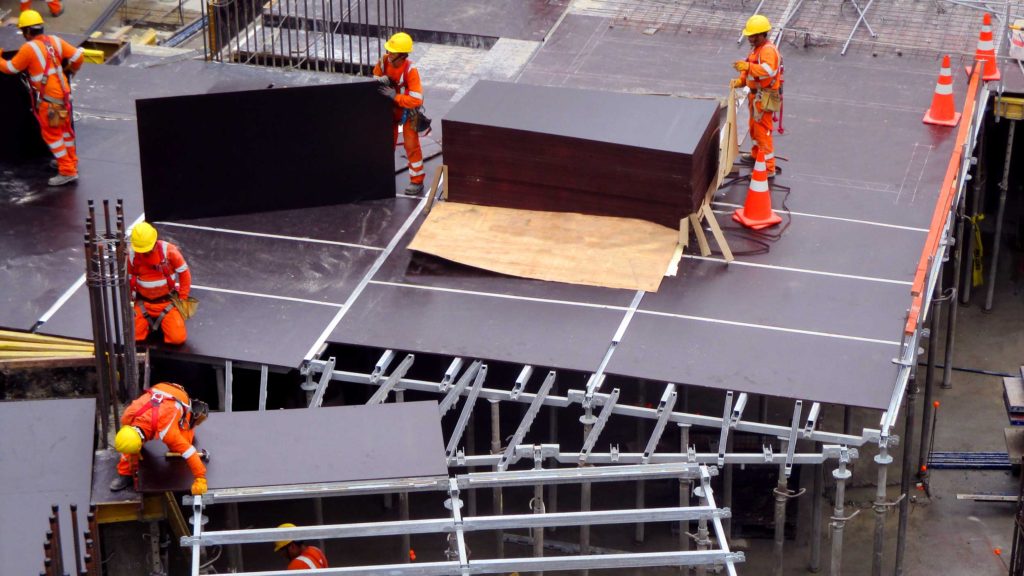Using quality formwork plywood is essential for increasing the strength of concrete structures but has to be meticulously constructed to ensure the foundations are 100 percent correct from day one.
Formwork plywood has become a stalwart in construction in Australia. Setting the foundations for a successful build is paramount.
In this article, we’ll take a look at both sides of the equation: a job well done, but also, when things go wrong, what will be the costly follow-on effects for all parties involved?
Here are some key points to consider:
Importance of Quality Formwork Plywood
- Durability: High-quality formwork plywood can withstand the pressure of wet concrete without warping or bending, ensuring the concrete sets correctly.
- Smooth Finish: It provides a smooth surface, reducing the need for additional finishing work on the concrete.
- Reusability: Good formwork plywood can be reused multiple times, making it cost-effective in the long run.
Pouring Concrete
- Preparation: Ensure the formwork is clean and properly aligned before pouring concrete. Any gaps or misalignments can weaken the structure.
- Pouring Technique: Pour the concrete evenly and avoid overloading any section of the formwork. This helps in achieving uniform strength throughout the structure.
- Vibration: Use vibration techniques to remove air bubbles, which can create weak spots in the concrete.
Choosing the Right Formwork Plywood
- Thickness: Select plywood with the appropriate thickness for the specific project. Thicker plywood is generally more durable and can handle more pressure.
- Type: Opt for plywood that is specifically designed for formwork, as it is treated to resist moisture and has a higher load-bearing capacity.
- Quality Standards: Ensure the plywood meets industry standards and certifications for formwork use.
Working with Formwork Plywood Contractors in Sydney
- Experience: Choose contractors with a proven track record in handling formwork plywood. Experienced contractors will ensure the formwork is set up correctly and efficiently.
- Reputation: Look for contractors with positive reviews and testimonials. A good reputation often indicates reliable and high-quality work.
- Cost: While cost is a factor, prioritise quality and experience over the cheapest option. Investing in good contractors can save money in the long run by preventing issues and ensuring a strong concrete structure.
By focusing on these aspects, you can significantly enhance the strength and durability of your concrete projects.
The Cost of any Errors or Mistakes in the Initial Phase Can be Disastrous
Mistakes during the initial stages of pouring concrete and setting up formwork can lead to several issues. Here are some potential pitfalls, hazards, and general problems:
Structural Weakness
- Improper Formwork Alignment: If the formwork is not properly aligned, the concrete structure can end up being uneven or misshapen, leading to weak points.
- Inadequate Support: Insufficient support for the formwork can cause it to collapse under the weight of the wet concrete, resulting in structural failure.
Surface Defects
- Poor Quality Formwork Plywood: Using low-quality plywood can lead to warping or bending, which affects the surface finish of the concrete, causing defects like honeycombing or surface cracks.
- Inadequate Sealing: Gaps or leaks in the formwork can allow concrete to seep out, leading to an uneven surface and potential weak spots.
Safety Hazards
- Formwork Collapse: If the formwork is not securely fastened or supported, it can collapse, posing a serious risk to workers on site.
- Improper Handling of Concrete: Pouring concrete too quickly or unevenly can cause splashing or spillage, which can be hazardous to workers and can also lead to an uneven pour.
Cost Overruns
- Rework and Repairs: Mistakes in the initial stages often require costly rework and repairs, which can significantly increase the overall project cost.
- Material Waste: Incorrectly set formwork or poor-quality plywood can lead to material wastage, further driving up costs.
Delays in Project Timeline
- Reconstruction: If the formwork fails or the concrete pour is not done correctly, it can lead to delays as the structure may need to be demolished and rebuilt.
- Inspection Failures: Poor workmanship can result in failing inspections, causing further delays as issues need to be rectified before proceeding.
Long-term Durability Issues
- Cracking and Spalling: Mistakes during the initial pour can lead to long-term issues like cracking and spalling, which compromise the durability and lifespan of the concrete structure.
- Water Ingress: Poorly set formwork can lead to water ingress, which can weaken the concrete over time and lead to structural damage.
Legal and Compliance Issues
- Non-compliance with Standards: Failing to adhere to industry standards and regulations can result in legal issues and fines, as well as the need to redo the work to meet compliance.
SUMMARY
Many of these potential problems can be avoided by paying close attention to the initial setup and pouring process, ensuring the use of high-quality formwork plywood and hiring experienced contractors. Getting off to a good solid start is everything in construction so make sure you are working with the right people and right machinery from the get-go. Good Luck!

